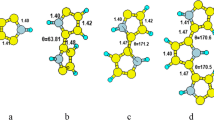Abstract
Ab initio crystal orbital calculation with the effective core potential (ECP) approximation is performed on infinite poly-yne, all-trans-polyethylene, and all-trans-polysilane. The optimized bond lengths of poly-yne are predicted to be 1.130 Å and 1.321 Å with the split valence LP-31G basis set and agree fairly well with 4-31G results, 1.166 Å and 1.339 Å.
The energy band structures of poly-yne and all-trans-polyethylene obtained from ECP calculations are in reasonable agreement with those from the all electron calculations. The fully optimized geometries of all-trans-polysilane are also predicted with the LP-31G basis set asr SiSi = 2.264 Å,r SiH = 1.493 Å,\(\sphericalangle\)SiSiSi = 118.97 °, and\(\sphericalangle\)HSiH = 100.35 °. The computational time for calculations of polysilane is found roughly to be comparative to that of polyethylene under ECP approximations.
Similar content being viewed by others
References
Del Re, G., Ladik, J., Biczo, G.: Phys. Rev.155, 997 (1967)
Andre, J. M.: J. Chem. Phys.50, 1536 (1969).
Bibliography ofab initio crystal orbital calculations was collected in: Kertesz, M., Koller, J., Azman, A.: Lecture Notes in Physics113, p. 56. Berlin-Heidelberg-New York: Springer 1980
Veillard, A.: Quantum theory in polymers, p. 23, Andre, J. M., Delhalle, J., Ladik, J. (eds). Dordrecht: Reidel 1978
Kahn, L. R., Baybutt, P., Truhler, D. G.: J. Chem. Phys.65, 3826 (1976); Melius, C. F., Goddard III, W. A., Kahn, L. R.: J. Chem. Phys.56, 3342 (1972); Melius, C. F., Goddard III, W. A.: Phys. Rev.A10, 1528 (1974)
Obara, S., Kitaura, K., Morokuma, K.: Theoret. Chim. Acta (Berl.)60, 227 (1981)
Andre, J. M., Bredas, J. L., Delhalle, J.: Int. J. Quantum Chem.19, 1105 (1981)
Nicolas, G., Durand, Ph., Burke, L. A.: Lecture Notes in Physics113, 201 (1980); Bredas, J. L., Chance, R. R., Silbey, R., Nicolas, G., Durand, Ph.: J. Chem. Phys.75, 255 (1982)
For example, see Whangbo, W. H., Hoffmann, R.: J. Am. Chem. Soc.100, 6093 (1978)
Kertesz, M., Koller, J., Azman, A.: J. Chem. Phys.68, 2779 (1978); Karpfen, A.: J. Phys.,C12, 3227 (1979)
Dewar, M. J. S., Yamaguchi, Y., Such, S. H.: Chem. Phys.43, 145 (1979), and references cited therein
Karpfen, A.: J. Chem. Phys.75, 238 (1981) and references cited therein
Reimer, J. A., Vaughan, R. W., Knights, J. C.: Phys. Rev. Letters44, 193 (1980)
We used the crystal orbital program coded by Suhai, S., Suhai, S.: J. Chem. Phys.73, 3843 (1980)
Roothaan, C. C. J.: Rev. Mod. Phys.23, 69 (1951)
Topiol, S., Moskowitz, J. W., Melius, C. F.: J. Chem. Phys.70, 3008 (1979)
Topiol, S., Osman, R.: J. Chem. Phys.73, 5191 (1980)
LP-31G basis sets are taken from GAUSSIAN 80 program. Binkley, J. S., Whiteside, R. A., Krishnan, R., Seeger, R., DeFrees, D. J., Schlegel, H. B., Topiol, S., Kahn, L. R., Pople, J. A.: Quantum Chemistry Program Exchange, Indiana University
Moskowitz, J. W., Topiol, S., Snyder, L. C., Ratner, M. A.: Int. J. Quantum Chem.19, 131 (1981)
Karpfen, A., Petkov, J.: Theoret. Chim. Acta (Berl.)53, 65 (1979); Lowdin, P. O.: Adv. Quantum Chem5, 185 (1970)
Hehre, W. J., Lathan, W. A., Ditchfield, R., Newton, M. D., Pople, J. A.: Quantum Chemistry Program Exchange, Indiana University
Armstrong, D. R., Jamieson, J., Perkins, P. G.: Theoret. Chim. Acta (Berl.)50, 193 (1978)
Koopmans, T.: Physica (The Hague)1, 104 (1933)
Huzinaga, S.: Approximate atomic function I. Alberta: University of Alberta 1971
Mulliken, R. S.: J. Chem. Phys.23, 1841 (1955)
Bock, H., Ensslin, W., Feher, F., Freund, R.: J. Am. Chem. Soc.98, 668 (1976)
Collins, T. C. in: Electronic structure of polymers and molecular crystals, p. 405, Andre, J. M., Ladik, J. (eds.). New York: Plenum, 1975
Pritchard, H. O., Skinner, H. A.: Chem. Rev.55, 745 (1955)
For example, see Kollman, P., McKelvey, J., Johansson, A., Rothenberg, S.: J. Am. Chem. Soc.97, 955 (1975).
Delhalle, J., Andre, J. M., Delhalle, S., Pireaux, J. J., Caudano, R., Verbist, J. J.: J. Chem. Phys.60, 595 (1974)
Karpfen. A.: Int. J. Quantum Chem.19, 1207 (1981)
Author information
Authors and Affiliations
Rights and permissions
About this article
Cite this article
Teramae, H., Yamabe, T. & Imamura, A. Ab initio effective core potential studies on polymers. Theoret. Chim. Acta 64, 1–12 (1983). https://doi.org/10.1007/BF00554147
Received:
Issue Date:
DOI: https://doi.org/10.1007/BF00554147




